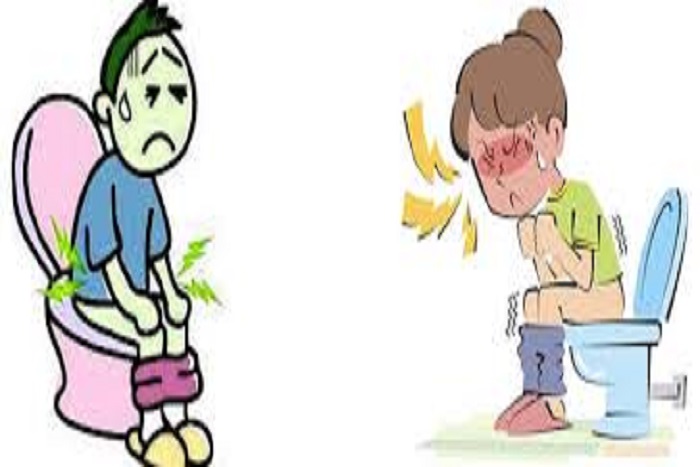
From a clinical perspective, diarrhoea can be defined as the passage of:
Based on duration, diarrhoea is classified as:
Normally approximately 10 litres of fluid consisting of ingested food and drink, in addition to secretions from the salivary glands, stomach, pancreas, bile ducts, and duodenum, enters the gastrointestinal tract every day. The small intestine is the major site for re-absorption. Overall, about 99% of the fluid is re-absorbed, leaving 0.1 litre to be excreted in the faeces. Diarrhoea occurs when various factors interfere with this normal process, resulting in decreased absorption or increased secretion of fluid and electrolytes, or increase in bowel motility.
Improved understanding of the pathophysiology of infectious diarrhoea, and the factors that promote the spread of causative infectious agents, will lead to practical approaches for preventing and responding to outbreaks.
– First assess for signs of dehydration.
– Then look for other signs:
• profuse watery diarrhoea (cholera, enterotoxigenic E. coli),
• repeated vomiting (cholera),
• fever (salmonellosis, viral diarrhoea),
• presence of red blood in stools: see also Shigellosis and Amoebiasis.
– In a patient over 5 years with severe and rapid onset of dehydration, suspect cholera.
General principles:
– Prevent or treat dehydration: rehydration consists of prompt replacement of fluid and electrolyte losses as required, until the diarrhoea stops.
– Administer zinc sulfate to children under 5 years.
– Prevent malnutrition.
– Do not systematically administer antimicrobials: only certain diarrhoeas require antibiotics.
– Do not administer anti-diarrhoeal drugs or antiemetics.
– Treat the underlying condition if any (malaria, otitis, respiratory infection, etc.).
Administer oral rehydration solution (ORS) according to the WHO Treatment Plan A to prevent dehydration.
Some ('moderate') dehydration
Administer ORS according to the WHO Treatment Plan B to treat some dehydration
Severe dehydration
Children under 5 years: 20 ml/kg of Ringer lactate (RL) over 15 minutes (to be repeated 2 times if necessary) then 70 ml/kg of RL over 3 hours
Children 5 years and over and adults: 30 ml/kg of RL over 30 minutes (to be repeated once if necessary) then 70 ml/kg of RL over 3 hours
Administer ORS as soon as possible in patients on IV fluids:
After each stool: 50 to 100 ml of ORS in children under 2 years; 100 to 200 ml of ORS in children aged 2 to 10 years; 200 to 250 ml of ORS in children over 10 years and adults.
Continue unrestricted normal diet. In breastfed children, increase the frequency of feeds. Breast milk does not replace ORS. ORS should be given between feeds.
Zinc sulfate is given in combination with oral rehydration solution in order to reduce the duration and severity of diarrhoea, as well as to prevent further occurrences in the 2 to 3 months after treatment:
zinc sulfate PO :
Children under 6 months: 10 mg (½ tablet) once daily for 10 days
Children from 6 months to 5 years: 20 mg (1 tablet) once daily for 10 days
Place the half-tablet or full tablet in a teaspoon, add a bit of water to dissolve it, and give the entire spoonful to the child.
Diarrhoea without blood
Most acute diarrhoeas are caused by viruses unresponsive to antimicrobials. Antimicrobials can be beneficial in the event of cholera or giardiasis.
– Cholera: the most important part of treatment is rehydration. In the absence of resistance (perform antibiotic-sensitivity testing at the beginning of an outbreak), antibiotic treatment shortens the duration of diarrhoea.
Diarrhoea with blood
– Shigellosis is the most frequent cause of bloody diarrhoea (amoebiasis is much less common). If there is no laboratory diagnosis to confirm the presence of amoebae, first line treatment is for shigellosis.
– Amoebiasis: antiparasitic treatment only if motile E. histolytica amoebae are found in stools or if a correct shigellosis treatment has been ineffective.
– Breastfeeding reduces infant morbidity and mortality from diarrhoea and the severity of diarrhoea episodes.
– When the child is weaned preparation and storage of food are associated with the risk of contamination by faecal micro-organisms: discourage bottle-feeding; food must be cooked well; milk or porridge must never be stored at room temperature.
– Access to sufficient amounts of clean water and personal hygiene (washing hands with soap and water before food preparation and before eating, after defecation etc.) are effective methods of reducing the spread of diarrhoea.